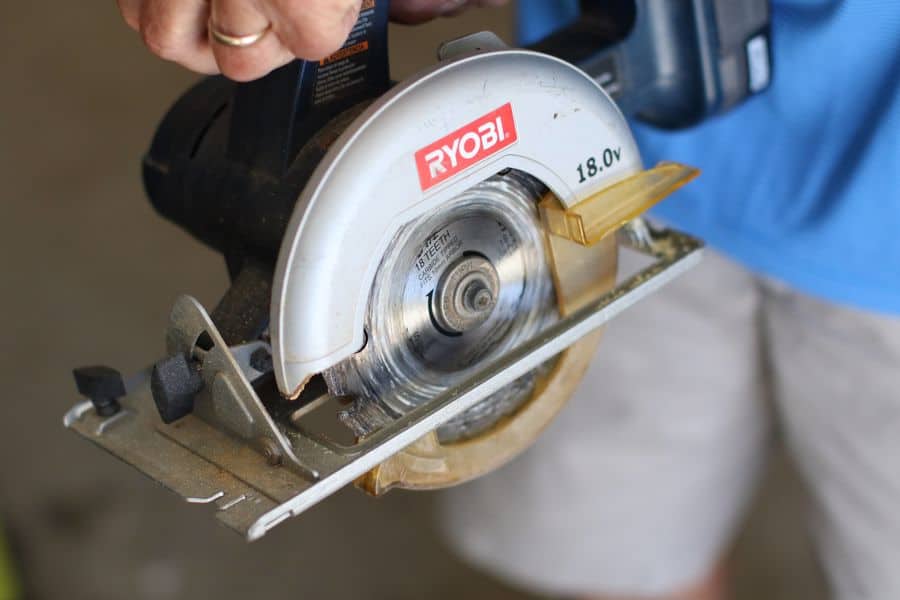As an Amazon Associate we earn from qualifying purchases.
Cutting a 60 degree angle is a relatively easy task with a miter saw. Or, a table saw can often adjust the bevel settings to accomplish this cut. But, if all you have is a circular saw, how do you make the cut, while keeping safe?
I’ll walk you through the process of safely cutting a 60 degree angle with your circular saw.
How To Cut 60 Degree Angle Using A Circular Saw
Making a 60-degree angle is not as simple as making a straight cut. This task requires more precise measurements so that you do not end up with an undesired cut.
Materials Required
Before starting, let’s look at the cutting essentials you will need while carving a 60-degree angle fitting.
- A circular saw
- An angle guide like a protractor or a speed square
- Safety glasses
- Plyboard/ wooden plank
The entire method aims to obtain clean and precise 60-degree angular cuts. If done correctly, the final product looks like a top-tier custom piece.

So, without further ado, let’s have a detailed study!
Step #1 Adjust the Depth of the Intended Cut
Initiate the procedure by first adjusting the depth of your cut.
Unplug your saw, pull out the blade guard, and set the blade up onto the board.
Now, keep on adjusting the saw’s base plate until the edge is at the ¼ position of the entire width of the board.
Use the depth-adjusting lever to fix the blade in that exact position.
Step #2 Set Your Angle Guide Up
A neat and precise angular cut needs a guide that tells whether the blade is going smoothly with the angle or not. For this, I often use a large metal protractor having all the tips marked.
Take the blade guide rail and set it up over the blade where you intend to cut.
The correct way of using it is to start clean and straight and then adjust the guide’s arms as you proceed further.
You can also watch this video to understand how to use the protractor illustratively.
Step #3 Retract the Blade Guard
Align your saw blade along with the marks on the base plate after retracting your blade guard.
It would be best to draw a line parallel to the intended cut before avoiding messy aimless cutting.
Step #4 Make a 60-Degree Cut
It’s convenient to divide the angle into two parts, each of 30-degrees, instead of directly making a 60-degree cut.
Adjust the saw as per the protractor to cut off a 30-degree first as it is easy and smaller to carve.
After the cut is done, rotate the blade to cut the same 30-degrees in the opposite direction of the previous amount, which gives you a perfect 60-degree finish.

—
Warning!
Since the angles require a twist while handling the blade, you must ensure that it is done with utmost care. All eyes must be on your edge and its guard. Moreover, use clamps to keep your boards in place while cutting. It reduces the risk of the board shifting its position while cutting.
—
Frequently Asked Questions
Can I Cut at Other Angles Using the Same Procedure?
All bevel angular cuts have their measurements. If you have mastered making a 60-degree cut, the procedure for cutting at 45 and 90 degrees is more or less the same.
However, they all differ in precision and the number of bends needed. So, it would be best if you went through their guides before initiating a cut using the same method.
Can a 60-Degree Cut Also Be Made on Thinner Plyboards?
Thinner planks or plyboards lack the thickness needed for a clean cut. But, you can go ahead with any board having 7.5 cm width. As it is always suggested that you start with ¼ depth of the board used, it is safer to go with the minimum limit.
Which Circular Saw Blade is Best for Making 60-degree Angles?
All circular saw blades are capable of carving an accurate angular cut. The only difference is the bore and depth diametric measurements. Depending upon your needs, you can choose different blades having different ardor sizes and depths.
Conclusion
The ease provided by the edges of a circular saw not only carves out perfect 60-degree finishes but also adds a new ‘angle’ to your otherwise scary woodcutting stories.
Despite being one of the most convenient power tools for use, the circular saw has its fair share of risks. Please take all the general precautions while using a circular saw.
Don’t bind your blade while carving the angles, as it may start pushing backward, leaving you wounded fatally.
The steps mentioned above in detail will help you understand the procedure better. Go through the guide and start making the perfect 60-degree fittings!
